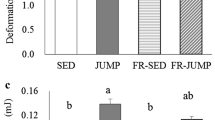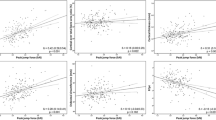Abstract.
Exercise, by way of mechanical loading, provides a physiological stimulus to which bone tissue adapts by increased bone formation. The mechanical stimulus due to physical activity depends on both the magnitude and the duration of the exercise. Earlier studies have demonstrated that jump training for 4 weeks produces a significant bone formation response in C57BL/6J mice. An early time point with significant increase in bone formation response would be helpful in: (1) designing genetic quantitative trait loci (QTL) studies to investigate genes regulating the bone adaptive response to mechanical stimulus; and (2) mechanistic studies to investigate early stimulus to bone tissue. Consequently, we investigated the bone structural response after 2, 3, and 4 weeks of exercise with a loading cycle of ten jumps a day. We used biochemical markers and peripheral quantitative computed tomography (pQCT) of excised femur to measure bone density, bone mineral content (BMC), and area. Four-week-old mice were separated into control (n= 6) and jump groups (n= 6), and the latter groups of mice were subjected to jump exercise of 2-week, 3-week, and 4-week duration. Data (pQCT) from a mid-diaphyseal slice were used to compare bone formation parameters between exercise and control groups, and between different time points. There was no statistically significant change in bone response after 2 weeks of jump exercise as compared with the age-matched controls. After 3 weeks of jump exercise, the periosteal circumference, which is the most efficient means of measuring adaptation to exercise, was increased by 3% (P < 0.05), and total and cortical area were increased by 6% (P < 0.05) and 11% (P < 0.01), respectively. Total bone mineral density (BMD) increased by 11% (P < 0.01). The biggest changes were observed in cortical and total BMC, with the increase in total BMC being 12% (P < 0.01). Interestingly, the increase in BMC was observed throughout the length of the femur and was not confined to the mid-diaphysis. Consistent with earlier studies, mid-femur bone mass and area remained significantly elevated in the 4-week exercise group when compared with the control group of mice. The levels of the biochemical markers osteocalcin, skeletal alkaline phosphatase, and C-telopeptide were not significantly different between the exercise and control groups, indicating the absence of any systemic response due to the exercise. We conclude that a shorter exercise regimen, of 3 weeks, induced a bone response that was greater than or equal to that of 4 weeks of jump exercise reported earlier.
Similar content being viewed by others
Author information
Authors and Affiliations
Additional information
Received: October 1, 2001 / Accepted: January 18, 2002
About this article
Cite this article
Umemura, Y., Baylink, D., Wergedal, J. et al. A time course of bone response to jump exercise in C57BL/6J mice. J Bone Miner Metab 20, 209–215 (2002). https://doi.org/10.1007/s007740200030
Issue Date:
DOI: https://doi.org/10.1007/s007740200030




